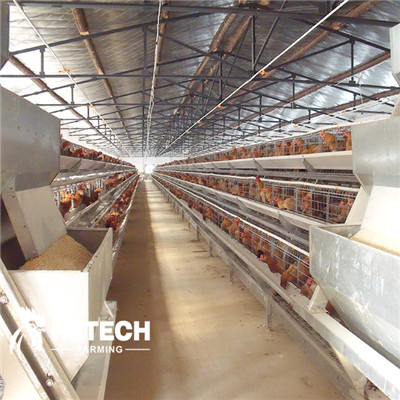Ọrụ nke vitamin naịzụ ọkụkọ.
Vitamin bụ otu klaasị pụrụ iche nke ala-molekul arọ organic ogige dị mkpa maka anụ ọkụkọ iji nọgide na-adị ndụ, uto na mmepe, nkịtị physiological ọrụ na metabolism.
Anụ anụ ọkụkọ nwere obere vitamin achọrọ, mana ọ na-arụ ọrụ dị mkpa na metabolism nke anụ ọkụkọ.
Enwere microorganisms ole na ole na tract digestive nke anụ ọkụkọ, na ọtụtụ vitamin enweghị ike ịmepụta ya n'ime ahụ, n'ihi ya, ha enweghị ike igbo mkpa ma a ga-ewepụ ya na nri.
Mgbe ọ na-erughị eru, ọ ga-akpata ọgba aghara nke metabolism ihe onwunwe, uto uto na ọrịa dị iche iche, na ọbụna ọnwụ n'ọnọdụ ndị siri ike. Ndị na-azụ anụ na ụmụ ọkụkọ nwere ihe siri ike chọrọ maka vitamin. Mgbe ụfọdụ, mmepụta akwa nke ọkụkọ adịghị ala, ma ọnụ ọgụgụ fatịlaịza na ọnụ ọgụgụ hatching adịghị elu, nke kpatara enweghị vitamin ụfọdụ.
1.Vitamin soluble abụba
1-1. Vitamin A (vitamin na-akwalite uto)
Ọ nwere ike ịnọgide na-ahụ anya nkịtị, chebe ọrụ nkịtị nke mkpụrụ ndụ epithelial na anụ ahụ akwara, na-akwalite uto na mmepe nke anụ ọkụkọ, na-amụba agụụ, na-akwalite mgbaze, ma kwalite iguzogide ọrịa na-efe efe na nje nje.
Enweghị vitamin A na nri ga-eduga n'ịkpu ìsì n'abalị na anụ ọkụkọ, na-eto ngwa ngwa, ọnụ ọgụgụ mmepụta akwa mbelata, mbelata ọnụ ọgụgụ fatịlaịza, ọnụ ọgụgụ dị nta nke ntanye, nkwụsị nke ọrịa na-adịghị ike, na ọrịa dị iche iche. Ọ bụrụ na vitamin A dị ukwuu na ndepụta nri, ya bụ, ihe karịrị 10,000 nkeji mba ụwa / kg, ọ ga-eme ka embrayo na-anwụ n'oge mmalite. Vitamin A bara ụba na mmanụ imeju imeju, karọt na hay alfalfa nwere ọtụtụ carotene.
1-2. Vitamin D
Ọ metụtara calcium na phosphorus metabolism na nnụnụ, na-akwalite absorption nke calcium na phosphorus na obere eriri afọ, na-achịkwa excretion nke calcium na phosphorus na akụrụ, na-akwalite nkịtị calcification nke ọkpụkpụ.
Mgbe anụ ọkụkọ bụ erughi na vitamin D, ahu si ịnweta metabolism na- disordered, nke na-egbochi mmepe nke ọkpụkpụ ya, na-akpata rickets, nro na bendable onu okuko, ụkwụ na sternum, mkpa ma ọ bụ nro eggshells, ibelata egg mmepụta na hatchability, ogbenye ibu, feathers siri ike, adịghị ike ụkwụ.
Agbanyeghị, oke vitamin D nwere ike ibute nsị anụ ọkụkọ. Vitamin D nke a kpọtụrụ aha n'ebe a na-ezo aka na vitamin D3, n'ihi na anụ ọkụkọ nwere ikike siri ike iji vitamin D3 mee ihe, na mmanụ imeju cod nwere D3 karịa.
1-3. Vitamin E
Ọ na-emetụta metabolism nke nucleic acid na redox nke enzymes, na-arụ ọrụ zuru oke nke membranes cell, ma nwee ike ịkwalite ọrụ mgbochi, melite nguzogide anụ ọkụkọ na ọrịa, ma welie mmetụta mgbochi nchekasị.
Enweghị vitamin E anụ ọkụkọ na-ata ahụhụ site na encephalomalacia, nke ga-ebute nsogbu ọmụmụ, mmepụta akwa dị ala na ike ịmịpụta. Ịtinye vitamin E na nri nwere ike ime ka ọnụ ọgụgụ hatching dịkwuo elu, kwalite uto na mmepe, na ịkwalite ọrụ mgbochi. Vitamin E bara ụba na fodder green, germ na nkochi ime akwa.
1-4. Vitamin K
Ọ bụ akụkụ dị mkpa maka anụ ọkụkọ iji nọgide na-enwe coagulation ọbara nkịtị, a na-ejikarị egbochi na ịgwọ ọrịa ọbara ọgbụgba nke ụkọ vitamin K kpatara. Enweghị vitamin K n'ime anụ ọkụkọ na-enwekarị ọrịa hemorrhagic, ogologo oge ịchịkọta ọnụ, na imebi obere arịa ọbara, nke nwere ike ibute nnukwu ọbara ọgbụgba. Ọ bụrụ na ọdịnaya vitamin K sịntetik karịrị 1,000 ugboro ihe a chọrọ, nsị ga-eme, vitamin K dịkwa n'ụba na nri akwụkwọ ndụ akwụkwọ ndụ na soybean.
2.mmiri soluble vitamin
2-1. Vitamin B1 (thiamine)
Ọ na-metụtara ịnọgide na-enwe carbohydrate metabolism na akwara ọrụ nke ọkụkọ, na-metụtara chiri anya na nkịtị mgbari usoro. Mgbe nri na-adịghị, ọkụkọ na-egosi ọnwụ nke agụụ, adịghị ike muscle, ibu arọ, mgbaze na ndị ọzọ phenomena. Enweghị ụkọ siri ike na-egosipụta dị ka polyneuritis nke na-atụgharị isi n'azụ. Thiamine bara ụba na nri ahịhịa ndụ na ahịhịa.
2-2. Vitamin B2 (riboflavin)
Ọ na-arụ ọrụ dị mkpa na redox na vivo, na-achịkwa iku ume cellular, na-ekere òkè na ike na protein metabolism. Na enweghị riboflavin, ụmụ ọkụkọ na-eto nke ọma, nwere ụkwụ dị nro, mkpịsị ụkwụ na-agbagọ n'ime, na obere ahụ. Riboflavin dị ukwuu na nri ahịhịa ndụ, nri hay, yist, nri azụ, bran na ọka wit.
2-3. Vitamin B3 (pantothenic acid)
Ọ metụtara carbohydrate, protein na abụba metabolism, dermatitis mgbe ụkọ, siri ike feathers, stunted ibu, mkpụmkpụ na oké ọkpụkpụ, ala lanarị ọnụego, isi obi na imeju, muscle hypoplasia, hypertrophy nke ikpere nkwonkwo, wdg Pantothenic acid bụ nnọọ ejighị n'aka na mfe mebiri mgbe agwakọta na ndepụta, otú calcium salts na-ejikarị dị ka ihe mgbakwunye. Pantothenic acid bara ụba na yist, bran na ọka wit.
2-4. Vitamin pp (niacin)
Ọ bụ akụkụ dị mkpa nke enzymes, nke na-agbanwe ghọọ nicotinamide n'ime ahụ, na-ekere òkè na mmeghachi omume redox na ahụ, ma na-arụ ọrụ dị mkpa n'ịkwado ọrụ nkịtị nke akpụkpọ ahụ na akụkụ nri nri. Ọchịchọ ụmụ ọkụkọ dị elu, enweghị agụụ, uto ngwa ngwa, nku na-adịghị mma na mwụfu, ọkpụkpụ ụkwụ gbagọrọ agbagọ, na ịdị ala dị ala; enweghị ọkụkọ ndị toro eto, ọnụ ọgụgụ mmepụta akwa, ịdị mma akwa akwa, ọnụ ọgụgụ hatching niile na-ada. Agbanyeghị, niacin dị ukwuu na nri ga-ebute ọnwụ embrayo na ọ̀tụ̀tụ̀ ịmụ nwa dị ala. Niacin bara ụba na yist, agwa, bran, akwụkwọ ndụ akwụkwọ ndụ na nri azụ.
Oge nzipu: Ọgọst-01-2022









